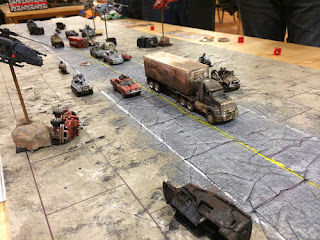Friday, October 13, 2017
Spectacle Vs The Rules: Some reflections on gaming with miniatures
There's just something about miniatures. My grandmother loved them (though I doubt she'd ever play 40k), and I've always loved them. My grandma would tell me that when she was hospitalized she had a set of army hospital figures (presumably marx or airfix back then) that she would play with and make up stories with. Nobody died in her war.
This link from miniature to imagination ignited a passion for scale figures in me long before I ever discovered games workshop and the various excesses of the local hobby store. I made my first boardgame when I was five using a plastic army man and a piece of copy paper. Fast forward 10 years later and there I am standing in the middle of a hobby shop having arrived fresh from the orthodontist. I had just gotten braces wired to my teeth, and the only thing I could think of that would make the self consciousness and horror of that experience go away was buying the 5th edition rulebook for warhammer 40,000. Mini games have always been there to inspire and comfort me.
Miniatures possess a certain quality of imaginative possiblity, coupled with a sensation of tactility that mirrors the satisfaction one might get from running your hands through warm sand. It's entrancing. And yet, I've found that those qualities of spectacle and sensation can rarely be matched by the rules systems that govern play with them.
Wargaming, the most common form of miniatures play, is almost exclusively about spectacle. Most of the rules systems available offer iterations around the core concept of lines of soldiers clashing together, inevitably resulting in a lot of spilt dice, measuring tape, and math. The strategies and number crunching can be engaging at times, but they are nothing compared to the pleasure of gazing at a table crammed with formations of spear wielding skeletons.
And that's fine for some. It's a niche hobby that attracts nobody I know personally. My own attempts at creating rules for wargames have resulted in some very bad and misguided projects (I devoted a sizeable portion of my freshman year in college to making a sci fi skirmish game that remains broken and sad). It's unfortunate that for most wargamers, the enjoyment of fielding armies and moving them around is often undercut by the dreariness of the combat rules. There seems to be an imagintive disconnect, where the stories of battle one has in one's head cannot be reconciled by the systems.
Is this a design issue? Possibly. Is it impossible to create a wargame that engages with the imagination through the crunch of the system as much as the spectacle does? The problem becomes that the more you shift towards narration and fantasizing the further you step towards roleplaying games, in which case the need for miniatures is reduced to almost nothing. Miniatures are used in wargames to model size and distance, little more. What else could they be used for? That's a design question.
But as I struggle to come to a decisive point in this stream of consciousness you've been subjected to, I'm reminded that some games spend years baking in your mind's oven before they can become anything. Perhaps augmented reality will come through and solve all problems. Perhaps not. I'd like to issue a challenge to anyone interested in miniature play, wargaming or otherwise, and that's to be as experimental as possible. To innovate in this form we need to do some deep diving into the magnetisim of the objects and materials first. From there we can begin to build back up into something one might call a rulebook. A grimoire, maybe. A book of magick, who knows? What we do not need by any measure is more D6 morale checks and fancy tables dicating whose sword can slice through more meat.
Subscribe to:
Post Comments (Atom)


No comments:
Post a Comment